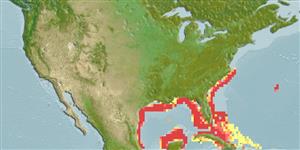>
Lophiiformes (Anglerfishes) >
Ogcocephalidae (Batfishes)
Etymology: Ogcocephalus: Greek, ogkos, ou = hook, curvature (Ref. 45335); corniger: From the long, upturned rostrum (corniger = horn-bearer) (Ref. 40824).
Environment: milieu / climate zone / depth range / distribution range
Ekologi
laut dasar (demersal); kisaran kedalaman 29 - 230 m (Ref. 40824). Subtropical; 37°N - 20°N
Western Atlantic: North Carolina and northern Gulf of Mexico in USA to southern Bahamas.
Size / Weight / umur
Maturity: Lm ? range ? - ? cm
Max length : 23.0 cm TL jantan/; (Ref. 7251)
deskripsi pendek
Morfologi | Morfometrik
Evenly covered by closely set pale spots on a darker background. Subopercular lateral-line scales usually 5-7. Differs from pumilus in having larger body size and fleshy pads on the ventral tips of the pectoral rays (absent in pumilus) (Ref. 40824).
Found typically on sandy bottoms (Ref. 27549).
Life cycle and mating behavior
Kematangan | Reproduksi, perkembang biakan | Pemijahan | telur-telur | Fecundity | Larva
Bradbury, M.G., 1980. A revision of the fish genus Ogcocephalus with descriptions of new species from the western Atlantic Ocean (Ogcocephalidae: Lophiiformes). Proc. Calif. Acad. Sci. 42(7):229-285. (Ref. 40824)
Status IUCN Red List (Ref. 130435)
ancaman kepada manusia
Harmless
penggunaan manusia
informasi lanjut
Nama-nama umumSinonim (persamaan)metabolismePemangsaEkotoksikologiReproduksi, perkembang biakanKematanganPemijahanSpawning aggregationFecunditytelur-telurpekembangan telor
Umur / SaizPertumbuhanpanjang-beratpanjang-panjangukuran frekuensiMorfometrikMorfologiLarvaDinamika larvapemulihanKelimpahanBRUVS
AcuanBudidaya airprofil budidaya airStrainGenetikaElectrophoresesDiturunkanPenyakit-penyakitPengolahanNutrientsMass conversion
mitraGambarStamps, Coins Misc.Suara-suaraCiguateraKecepatanTipe renangArea insangOtolithsOtakPenglihatan / visi
Alat, peralatan
laporan khas
muat turun XML
Sumber internet
Estimates based on models
Preferred temperature (Ref.
123201): 18.3 - 27.4, mean 23.5 °C (based on 69 cells).
Phylogenetic diversity index (Ref.
82804): PD
50 = 0.5001 [Uniqueness, from 0.5 = low to 2.0 = high].
Bayesian length-weight: a=0.02291 (0.00925 - 0.05675), b=2.94 (2.72 - 3.16), in cm total length, based on LWR estimates for this (Sub)family-body shape (Ref.
93245).
Trophic level (Ref.
69278): 3.4 ±0.6 se; based on size and trophs of closest relatives
Daya lenting (Ref.
120179): sedang, Waktu penggandaan populasi minimum 1.4 - 4.4 tahun (Preliminary K or Fecundity.).
Fishing Vulnerability (Ref.
59153): Low vulnerability (13 of 100).
